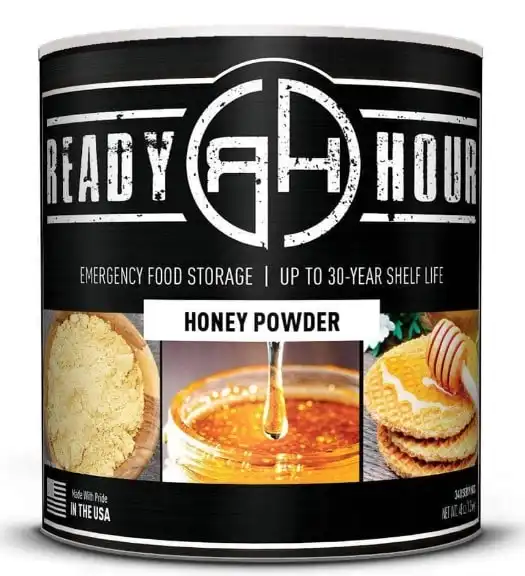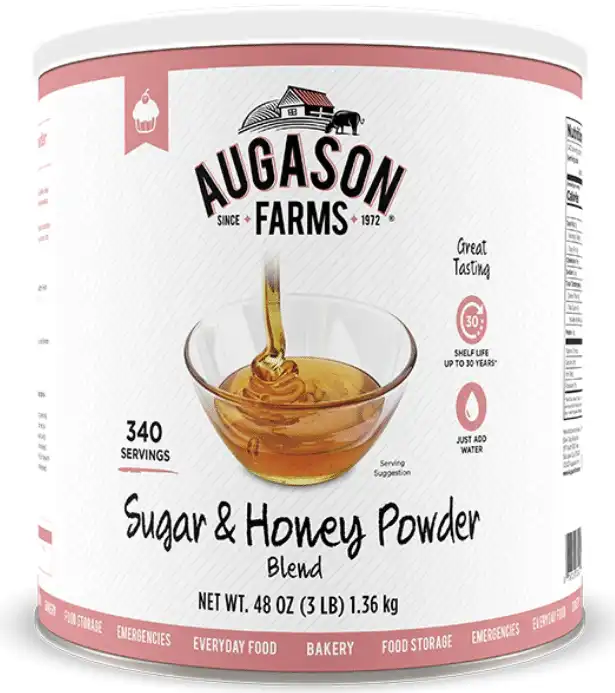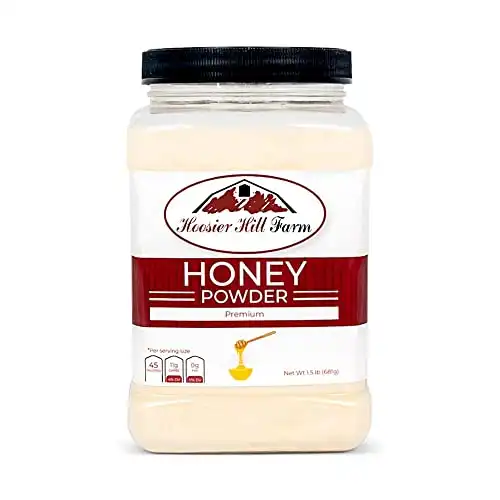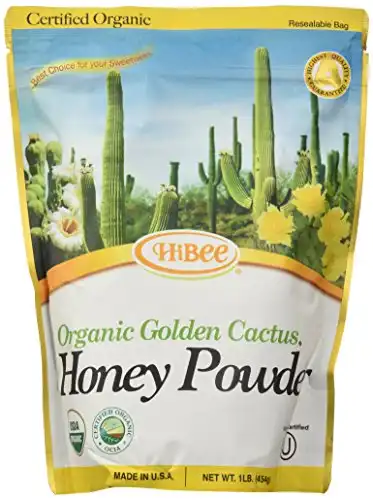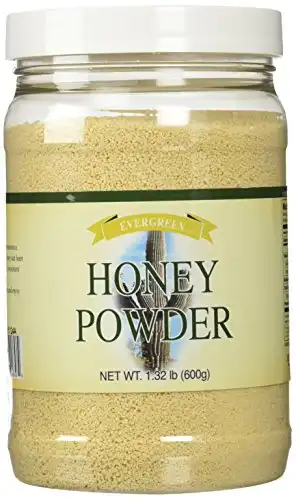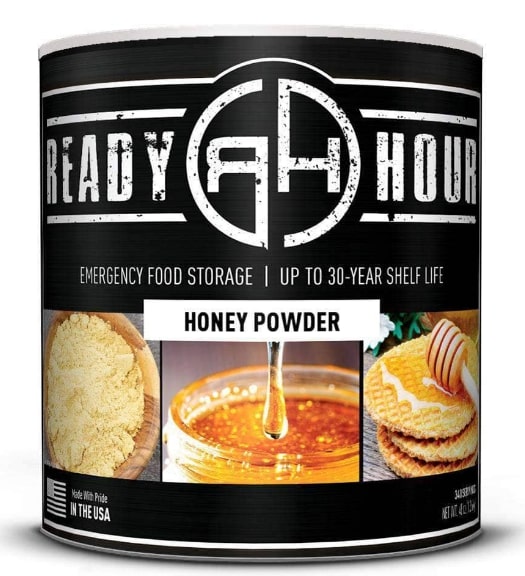
A Complete Guide To Buying & Using Honey Power
Why? Because honey has so many amazing health benefits.
And while living without honey is possible, WHY would you want to?
- What’s your plan if the grocery store is out of honey for the foreseeable future?
- How can you get honey’s vitamins and minerals in a long-term crisis?
HONEY POWDER! If you plan ahead…
TOPICS IN THIS GUIDE… ↓(click to jump)
- Best Honey Powder Deals…
- What Is Honey Powder?
- How Is Honey Powder Made?
- Can You Make Your Own?
- Is Honey Healthy?
- How Long Will It Last?
- How To Use Powdered Honey
- Why Stock Up On Honey Dust

Want a free family-first food planning guide?
Enter your email below to instantly download this Complete Guide PDF. No purchase necessary. 👇 👇Best Powdered Honey On The Market Today
My Patriot Supply is a mainstay for the prepper community.
This family-owned and operated outfit provides some of the best survival food on the market today.
Part of the Ready Hour series, their powdered honey comes in a sealed 3.8 lb. #10 can.
It has a 30+ year shelf life and 1-year shelf life after opening.
It’s also more affordable than you might think.
Auguson Farm is another family-owned and operated prepper paradise.
They are some of the original pioneers of emergency food and have the process perfected.
Their powder comes in a sealed #10 can and has 340 servings of honey goodness.
It also boasts a 30+ year shelf life.
Even better, it has a very attractive price tag.
↓ Augason Farms Honey
Hoosier Hill is yet another excellent business you might already be familiar with.
Anyone interested in emergency food and prepping should know about their quality products.
Their honey dust comes in slightly smaller packages of 1.5 each.
It also comes in plastic jugs rather than sealed cans.
However, the high quality of their Manuka-sourced honey makes the purchase worth it.
This product is a little different from the others on the list.
However, it is worthwhile if you have a sweet tooth and want to try something new.
Hibee’s cactus powder is made out of agave rather than bee-produced honey.
The result is a great granular dried honey product if you’re looking to branch out.
Plus, it’s a great deal.
Evergreen’s powder is especially popular among folks who bake.
It has a granulated feel and is best used in recipes.
Note it's also made with a good deal of cane sugar.
This means it isn’t quite a standard honey.
However, like Hibee’s product, it can still be very useful.
What Is Honey Powder?
Honey starts as flower nectar and honeydew (sugary residue from other insects).
Foraging bees collect nectar and honeydew.
They store it in an organ called the proventriculus or “honey stomach”.
And return it to their hive.
They then regurgitate it, transferring it to worker bees.
The bees digest the nectar together, passing it back and forth.
Enzymes in their honey stomachs make the nectar more acidic by breaking down starches and proteins.
The enzymes also convert the nectar’s sucrose to glucose and fructose.
After digestion, the honey solution is 50-70% water and contains natural yeast.
The bees transport the honey to the hive’s honeycombs and store it in its cells.
The cells are left unsealed, and the bees heat the area around the honeycombs with their bodies.
They maintain a temperature of around 95 degrees F.
The heat speeds up evaporation and reduces the water content of the honey to around 18%.
It also raises the sugar concentration beyond the saturation point.
These changes prevent fermentation, which would spoil the honey.
When the process is complete, the bees seal the cells with wax caps.
If the honey is for human consumption, the next step is to remove the honeycomb.
Usually, beekeepers subdue the bees beforehand.
They sometimes do this with smoke, which triggers a feeding reflex and makes the bees less aggressive.
Keepers remove the honeycomb and extract the honey.
The honey is often filtered to remove pieces of honeycomb and other debris.
Sometimes, other sugars and compounds are added to honey.
This is referred to as “adulteration.”
According to the USDA, a product cannot be labeled as “honey” or “pure honey” if it has been adulterated.

Want a free 78 item bug out bag checklist?
Enter your email below to instantly download this Complete Checklist PDF. No purchase necessary. 👇 👇How Is Powdered Honey Made?
Pure honey is dehydrated until all or most of the moisture has evaporated.
There are several ways that liquid honey is turned into powder commercially.
The main method is spray drying.
This process involves spraying the honey through an atomizer into a heated chamber.
Hot air streams are shot into the chamber and evaporate the moisture in the honey.
The dried honey is then ground down into a fine powder.
Another way to make powdered honey is by freeze-drying.
This process is also known as cryodesiccation.
This method involves freezing the honey in a chamber and then lowering the pressure in the container.
The lowered pressure causes a reaction called sublimation.
This reaction removes the ice (i.e., the moisture) from the frozen honey.
This leaves behind powdered honey, which is often further ground for consistency.
↓ Beekeeping: How We Dehydrate Honey
Can I Make My Own Dehydrated Honey?
Yes, you can.
The only major downside is that the process is somewhat time-consuming.
However, if you have the time and equipment, you can easily make powdered honey at home.
DIY Honey Powder Recipe
There are two main ways to dry honey:
We will call one “the dehydrator” method and the other “the candy” method.
Dehydrator Method
For this recipe, you will need the following:
- Food dehydrator
- Cookie sheet or parchment paper
- Spatula
- Mortar and pestle or a food processor
It is best to use a food dehydrator for this recipe. However, you can use an oven instead if you don’t have a food processor.
Just make sure to be extra careful about temperature regulation.
Note: This recipe usually takes 24-48 hours to complete.
While it is a “set it and forget it” process, you should expect it to take one to two days.
- Line the tray of the dehydrator with the cookie sheet.
- Pour honey over the sheet. Use the spatula to spread the honey out. Most of the sheet should be covered with a layer of honey 1/8th of an inch thick.
- Set your dehydrator to 120 degrees F. Make sure not to let the temperature rise much higher than 120 degrees. Higher temperatures will burn the honey.
- Let the dehydrator run for 24-48 hours until the honey is crisp.
- Once the honey is crisp, remove it from the dehydrator. Let it cool to room temperature. Cool your honey in a dry place if possible. Avoid drying your honey in areas with excess humidity.
- Granulate your honey with either your food processor or your mortar and pestle. Continue grinding until you have a fine powder.
- Pour the powder into sealable containers. For long-term storage, add a desiccant pouch. Seal the containers and store them.
Candy Method
For this recipe, you will need the following:
- An oven
- Silicone (not parchment) cookie sheets
- Candy thermometer
- Large pot
- Silicone spatula
- Food processor or mortar and pestle
↓ Making Honey Sugar
- Pour the honey into the pot. Cook until the honey is 300 degrees (measure it with the candy thermometer). Stir continually to prevent burning.
- Once the honey hits 300 degrees, remove the pot from the flame.
- Pour the honey onto the baking sheet right away. Use the spatula to spread it 1/8th of an inch thick.
- Let the honey cool until it reaches a “hard crack” consistency.
- Once the honey is fully cooled and hardened, remove it from the sheet. Use a mortar, pestle, or food processor to grind it into powder.
- Transfer the powder to a sealable jar. Add a desiccant pouch for long-term storage.

Want a free 78 item bug out bag checklist?
Enter your email below to instantly download this Complete Checklist PDF. No purchase necessary. 👇 👇Is Honey Healthy?
It has several major health benefits as a food source.
It has also been used medicinally throughout history and may have therapeutic properties.
The health advantages of honey include the following:
Great Source of Vitamins and Minerals
It contains many essential vitamins and minerals.
The benefits of these vitamins and minerals increase if you eat large amounts of honey regularly.
They include:
- Vitamin C (for healthy bones, blood, skin, and cells)
- Many B-Complex Vitamins (essential for digestion and multi-system health)
- Calcium (for heart health as well as healthy bones, muscles, and nerves)
- Potassium (for heart, nerve, cell, and muscle health)
- Zinc (for a healthy immune system and metabolism)
- Copper (for multi-system health)
- Iron (for blood health)
- Magnesium (for disease prevention, muscle and nerve health, and energy production)
- Folic Acid (for healthy red blood cells)
- Selenium (for reproductive and thyroid health, cell health, and protection from free radicals)
Honey also has several beneficial bioactive plant compounds and antioxidants.
These include the powerful combo of organic acids and phenolic compounds (such as flavonoids).
Antioxidants like these can help prevent heart disease, cancer, and strokes.
In particular, the antioxidants in Manuka honey may be linked to lower blood pressure.
Antibacterial and Antiseptic
Honey has been found to have antiseptic and antibacterial properties.
This means it can help disinfect burns and wounds and clear up infections.
It is antimicrobial and can fight fungi, viruses, and bacteria.
It has even been found to fight antibiotic-resistant bacteria.
An enzyme found in honey (glucose oxidase) also naturally produces hydrogen peroxide when combined with water.
Honey is likely more effective as an antibacterial/antiseptic in its original form.
However, honey can still be beneficial when used in salves and other balms.
May Improve Cholesterol
Honey may improve cholesterol levels.
Studies have shown that it can reduce total and “bad” (LDL) cholesterol while raising “good” (HDL) cholesterol.
Reducing bad cholesterol significantly reduces the chances of heart disease.
May Lower Triglyceride Levels
High levels of triglycerides increase the risk of heart disease and insulin resistance/type 2 diabetes.
Several studies have indicated that regularly eating honey may lower your triglyceride levels.
This is especially true when you use honey to replace sugar.
Good for the Hair and Skin
One of the oldest uses of honey is for hair and skin.
Mix it with olive oil and use it as a deep conditioner.
Let sit for 20 minutes, and then shampoo as normal.
Additionally, honey can cleanse, nourish, and moisturize skin.
This is largely due to its antibacterial and anti-inflammatory properties.
You can also use it as a spot treatment for acne.
It Aids Digestion and Eases Acid Reflux
Honey can aid digestion in several ways.
The antibiotic and anti-inflammatory properties can help with several stomach problems.
These include digestive problems, acid reflux, diarrhea, stomach ulcers, cramping, and constipation.
It is also a potent prebiotic.
This means that it nourishes the good bacteria in your gut that help with digestion.
The honey can be especially helpful as a digestive aid when mixed with equal parts apple cider vinegar and diluted with water.
Cough and Sore Throat Remedy
Honey is well-known for its ability to help with sore throats, especially when added to hot tea.
This is likely due to its ability to calm inflamed membranes in the throat.
Honey is also a powerful cough suppressant.
Studies have suggested it can be as effective as dextromethorphan (the main ingredient in many OTC cough meds).
Note: Honey may contain dormant spores of a type of botulism, which can be dangerous to infants.
Honey of any kind ( should never be given to children under 1 year old.
How Long Does Honey Powder Last? What is the Best Way to Store It?
One of the biggest benefits of honey is its outstandingly long shelf life.
It is among the longest-lasting foods known to man.
Honey unearthed from Egyptian tombs was found to still be edible after thousands of years.
Honey is so well-known for its long shelf life that it has been used to preserve other foods.
Honey’s naturally long shelf life likely comes from an enzyme bees produce.
The enzyme glucose oxidase makes honey acidic and suppresses bacterial growth.
This means that properly stored honey has virtually no shelf life!
This applies to powder as well as regular honey.
Commercially packaged powder usually has an official shelf-life (often 20-30 years).
However, properly stored honey dust can last far longer than that.
This makes it an excellent addition to any long-term food store.
Honey suguar is also very easy to store.
You can store it in any size or shape of a sealable container.
This can be especially useful for people with limited storage space.
It is best when kept in a cool, dry place (ideally no warmer than 75 degrees F).

Want a free 78 item bug out bag checklist?
Enter your email below to instantly download this Complete Checklist PDF. No purchase necessary. 👇 👇How Do I Use Powdered Honey?
Honey is incredibly versatile.
For one thing, you can reconstitute most commercial powders.
To reconstitute, gradually mix one cup of powder with ¼ cup of water in a saucepan.
Bring the mixture to a boil, reduce heat, and simmer for 5-10 minutes.
Continue stirring throughout the process.
After simmering, remove your saucepan from the flame and let it cool.
You can use the cooled honey like regular honey and store it in sealable containers.
Honey dust can also be used in powdered form in several ways.
It has many uses in the kitchen, including:
- As a sugar substitute
- In salad dressings (with olive oil and apple cider vinegar)
- For glazes and marinades
- In stir-fry’s
- For tea, coffee, and smoothies
- Baked into bread, pretzels, and dinner rolls for extra sweetness
- In batters for cakes and other baked desserts
- For canning recipes (like jams and preserved fruits)
- In dehydrator recipes (like dried fruits)
- In compound honey butter
- Sprinkled over hot cereals like oatmeal
- Sprinkled over fresh fruits
- On nuts and seeds before roasting
It can also be used medicinally in many different ways, including:
- As a deep conditioner for your hair
- In tea as a throat remedy
- Combined with apple cider vinegar and water to aid digestion
- As a skin scrub
- For healing as an agent for burns, cuts, or other wounds
- As a cough remedy
- As a spot solution for acne
Top Reasons To Stock Up On Honey Dust
There are many excellent reasons to include some honey in long-term food stores.
Nutritious
It’s a healthy food that can contribute nutrients to your diet.
It is important to keep nutritious foods in your store.
It helps ensure you and your family get everything you need to be healthy.
Calorically Dense
When it comes to survival food, one of the most essential qualities is caloric density.
This means that the food gives you a large bang for your buck in calories.
In a SHTF scenario, having as many calories as possible may be beneficial.
Honey is a calorically dense food.
One tablespoon (21 grams) of honey contains 64 calories.
It can also provide essential energy boosts if used while away from home.
Medicinal Properties & Other Uses
In the absence of more conventional medicine, honey can be essential.
You can apply it to specific ailments (i.e., a wound/burn or a cough).
It can also reduce the risk of disease (i.e., heart disease and insulin resistance).
Extremely Long Shelf Life
One of the biggest benefits is its impressive shelf life.
Properly stored dried honey will last you as long as needed.
This is essential when food access is interrupted long-term or indefinitely.
Easy to Store and Transport
It’s lightweight, durable, and not fussy to store.
This is an enormous advantage for preppers with limited space.
It’s also easy to carry and transport.
Versatile and Easy to Use
Long-term food stores benefit greatly from versatile foods.
It’s extremely versatile.
You can use it as an ingredient in many recipes.
You can also use it as a sugar substitute or to liven up tired dishes.
Additionally, you can use it in DIY medicine and skin/hair care.
It also gives you all of the benefits of honey without the hassle of, for instance, measuring a thick liquid out for recipes.
In terms of uses, honey dust pulls its weight.
Final Thoughts
If you enjoyed this article, you should check out the following survival food articles as well:
- 10 Best Powdered Milk With An Extreme Shelf Life For Emergencies
- 8 Best Powdered Peanut Butter With An Extremely Long Shelf Life
- 9 Best Powdered Eggs (and Deals) On The Market Today
Lana Adler
P.s - I just took this FREE 60-second 'Readiness Score Quiz'👇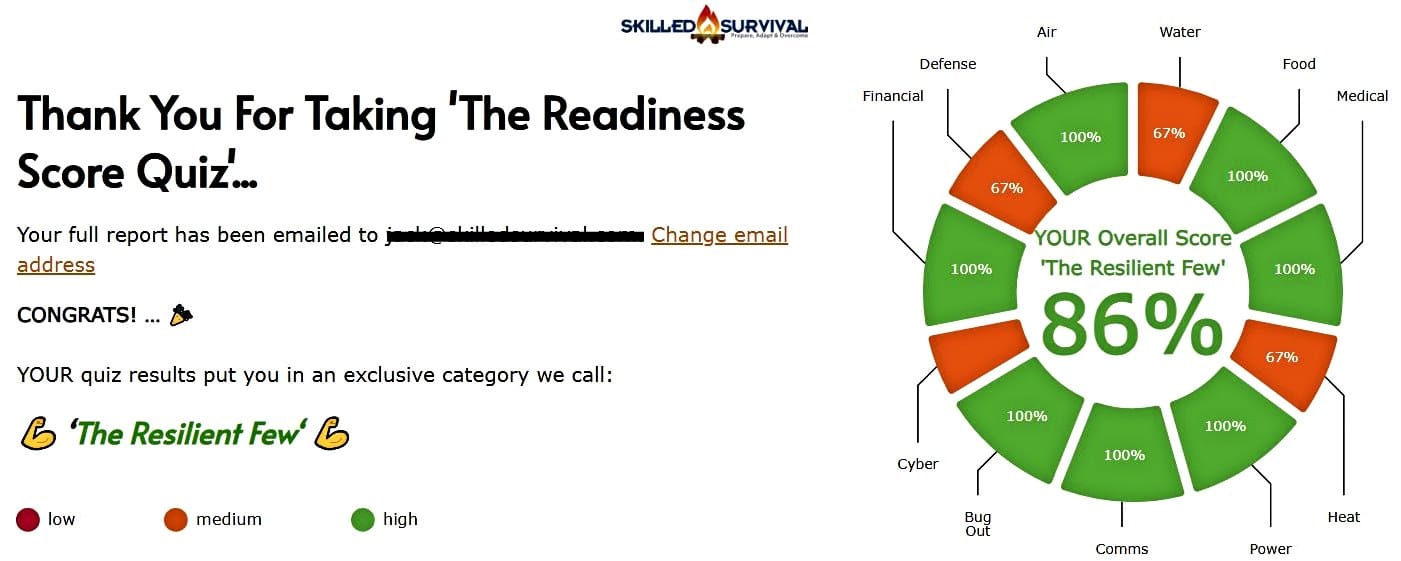
AND... I've still got a few gaps in my preps...🤔 But at least, I'm not part of 'The Fragile Masses'. 👍 Find out where YOU stand by answering a few questions...

Recommended Reading
Best Canned Meats To Round Out Your Food Stockpile
Not all canned meats are created equal. Most are great for a quick meal but we review the best ones to add to your emergency pantry.
Best Powdered Milks With An Insanely Long Shelf Life
Not all powered milks are created equal. We've uncovered all the best deals and share tactics on how to significantly extend it's shelf life.
Best Grain Mills To Grind Your Own Grains At Home
Need help finding the best grain mill for you? We show you the key features to look for (and avoid) - plus the 9 best on the market today
Best Powdered Eggs (& Deals) On The Market Right Now
The best powdered eggs are tasty, affordable, long lasting and worth buying! In this guide, we review the best ones to make your search easy.
Best Canned Breads (& Mixes) With Insanely Long Shelf Lives
The best canned breads are tasty, affordable, long lasting and worth buying! In this guide, we review the best ones on the market to make your search easy.
Best Powdered Peanut Butters With Insanely Long Shelf Life
Best Peanut Butter Powders for long term protein storage - 1. Ready Hour 2. Augason Farms 3. Legacy Foods 4. PBfit 5. Naked PB 6. PB2 Pure...

